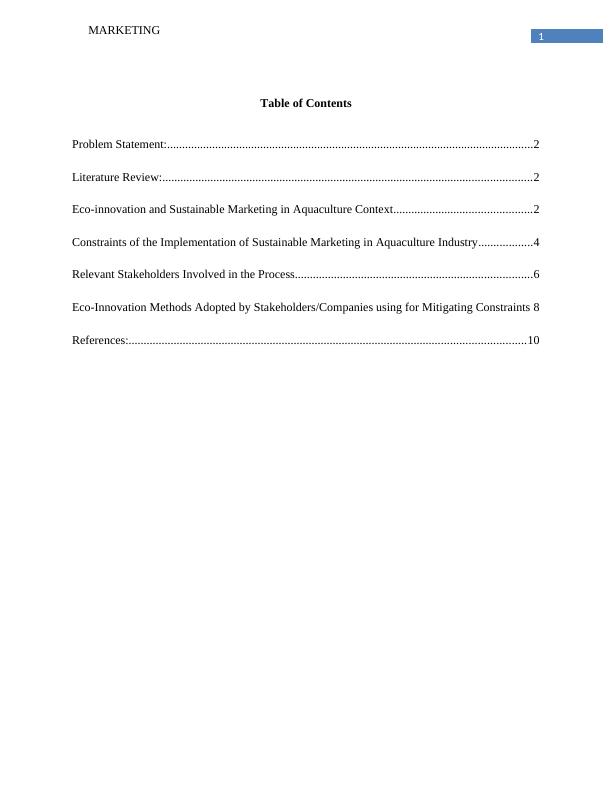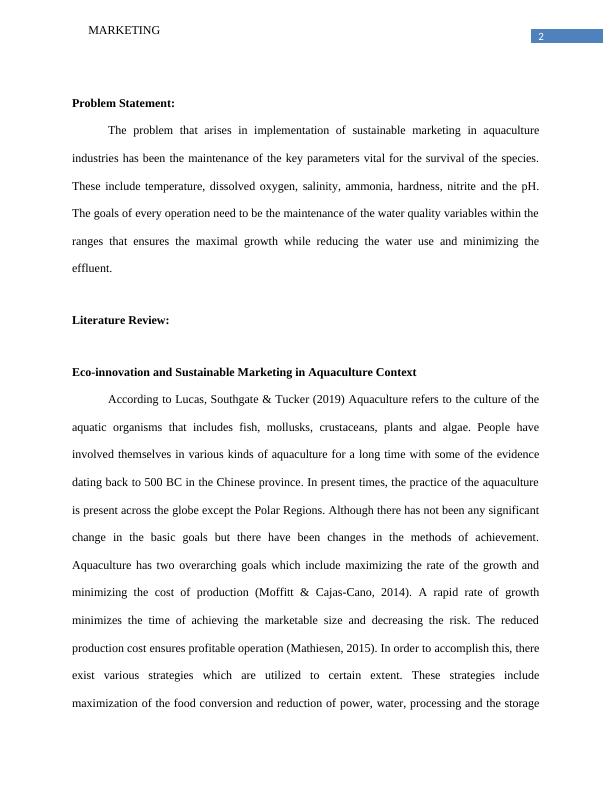The role of Eco-innovation in sustainable marketing implementation in Acq
Added on 2023-04-24
13 Pages2831 Words150 Views
Running head: MARKETING
The role of Eco-innovation in sustainable marketing implementation in Acq
Name of the Student:
Name of the University:
Author Note:
The role of Eco-innovation in sustainable marketing implementation in Acq
Name of the Student:
Name of the University:
Author Note:

1
MARKETING
Table of Contents
Problem Statement:..........................................................................................................................2
Literature Review:...........................................................................................................................2
Eco-innovation and Sustainable Marketing in Aquaculture Context..............................................2
Constraints of the Implementation of Sustainable Marketing in Aquaculture Industry..................4
Relevant Stakeholders Involved in the Process...............................................................................6
Eco-Innovation Methods Adopted by Stakeholders/Companies using for Mitigating Constraints 8
References:....................................................................................................................................10
MARKETING
Table of Contents
Problem Statement:..........................................................................................................................2
Literature Review:...........................................................................................................................2
Eco-innovation and Sustainable Marketing in Aquaculture Context..............................................2
Constraints of the Implementation of Sustainable Marketing in Aquaculture Industry..................4
Relevant Stakeholders Involved in the Process...............................................................................6
Eco-Innovation Methods Adopted by Stakeholders/Companies using for Mitigating Constraints 8
References:....................................................................................................................................10

2
MARKETING
Problem Statement:
The problem that arises in implementation of sustainable marketing in aquaculture
industries has been the maintenance of the key parameters vital for the survival of the species.
These include temperature, dissolved oxygen, salinity, ammonia, hardness, nitrite and the pH.
The goals of every operation need to be the maintenance of the water quality variables within the
ranges that ensures the maximal growth while reducing the water use and minimizing the
effluent.
Literature Review:
Eco-innovation and Sustainable Marketing in Aquaculture Context
According to Lucas, Southgate & Tucker (2019) Aquaculture refers to the culture of the
aquatic organisms that includes fish, mollusks, crustaceans, plants and algae. People have
involved themselves in various kinds of aquaculture for a long time with some of the evidence
dating back to 500 BC in the Chinese province. In present times, the practice of the aquaculture
is present across the globe except the Polar Regions. Although there has not been any significant
change in the basic goals but there have been changes in the methods of achievement.
Aquaculture has two overarching goals which include maximizing the rate of the growth and
minimizing the cost of production (Moffitt & Cajas-Cano, 2014). A rapid rate of growth
minimizes the time of achieving the marketable size and decreasing the risk. The reduced
production cost ensures profitable operation (Mathiesen, 2015). In order to accomplish this, there
exist various strategies which are utilized to certain extent. These strategies include
maximization of the food conversion and reduction of power, water, processing and the storage
MARKETING
Problem Statement:
The problem that arises in implementation of sustainable marketing in aquaculture
industries has been the maintenance of the key parameters vital for the survival of the species.
These include temperature, dissolved oxygen, salinity, ammonia, hardness, nitrite and the pH.
The goals of every operation need to be the maintenance of the water quality variables within the
ranges that ensures the maximal growth while reducing the water use and minimizing the
effluent.
Literature Review:
Eco-innovation and Sustainable Marketing in Aquaculture Context
According to Lucas, Southgate & Tucker (2019) Aquaculture refers to the culture of the
aquatic organisms that includes fish, mollusks, crustaceans, plants and algae. People have
involved themselves in various kinds of aquaculture for a long time with some of the evidence
dating back to 500 BC in the Chinese province. In present times, the practice of the aquaculture
is present across the globe except the Polar Regions. Although there has not been any significant
change in the basic goals but there have been changes in the methods of achievement.
Aquaculture has two overarching goals which include maximizing the rate of the growth and
minimizing the cost of production (Moffitt & Cajas-Cano, 2014). A rapid rate of growth
minimizes the time of achieving the marketable size and decreasing the risk. The reduced
production cost ensures profitable operation (Mathiesen, 2015). In order to accomplish this, there
exist various strategies which are utilized to certain extent. These strategies include
maximization of the food conversion and reduction of power, water, processing and the storage

3
MARKETING
cost. Food however remains critical to the aquaculture since it constitutes close to over 50
percent of the production cost and also since it provides energy inputs required for the
achievement of the maximum growth. In aquaculture feeds ranges from the live to the
formulated diets that often changes as the species mature and develop.
In the context of the aquaculture, eco-innovation refers to development of processes and
products that contributes to the sustainable development there ensuring the commercial
application of the knowledge through indirect or direct ecological improvements (Bossle et al.,
2016). This takes into account range of linked ideas from the environment friendly advances in
technology to the socially accepted innovative paths of sustainability. It is basically the field of
the research that seeks in explaining the rate of the newer ecological technology and idea spread
known as the eco innovation diffusion.
Sustainable marketing represents an aspect within wider field of the sustainable
development of community which is a field defined by Brundtland Commission of World
Commission when development meets the present needs without a compromise on the future
generations in meeting own needs(Lii, Wu & Ding, 2013). In context of the aquaculture context,
sustainable marketing has three fundamental principles. This includes (Vasiljević & Savić 2014):
Social engagement and waste reduction: Waste is available in various forms depending
on business or the enterprise where it is marketed. The example ranges from the elimination of
the waste from the product packaging like prohibition on the use of plastic wrappings for
packaging.
MARKETING
cost. Food however remains critical to the aquaculture since it constitutes close to over 50
percent of the production cost and also since it provides energy inputs required for the
achievement of the maximum growth. In aquaculture feeds ranges from the live to the
formulated diets that often changes as the species mature and develop.
In the context of the aquaculture, eco-innovation refers to development of processes and
products that contributes to the sustainable development there ensuring the commercial
application of the knowledge through indirect or direct ecological improvements (Bossle et al.,
2016). This takes into account range of linked ideas from the environment friendly advances in
technology to the socially accepted innovative paths of sustainability. It is basically the field of
the research that seeks in explaining the rate of the newer ecological technology and idea spread
known as the eco innovation diffusion.
Sustainable marketing represents an aspect within wider field of the sustainable
development of community which is a field defined by Brundtland Commission of World
Commission when development meets the present needs without a compromise on the future
generations in meeting own needs(Lii, Wu & Ding, 2013). In context of the aquaculture context,
sustainable marketing has three fundamental principles. This includes (Vasiljević & Savić 2014):
Social engagement and waste reduction: Waste is available in various forms depending
on business or the enterprise where it is marketed. The example ranges from the elimination of
the waste from the product packaging like prohibition on the use of plastic wrappings for
packaging.

End of preview
Want to access all the pages? Upload your documents or become a member.
Related Documents
Report on Profitability in Sustainability Egyptlg...
|4
|726
|36
Sustainable Tourism Developmentlg...
|14
|814
|84
Eco-friendly Chemistry Tasklg...
|7
|1653
|15
Science in Agriculture - Assignmentlg...
|8
|1828
|36
Marketing Management Digital Communicationlg...
|7
|1560
|11
(Sample) Creativity and Innovation : Assignmentlg...
|11
|759
|17
